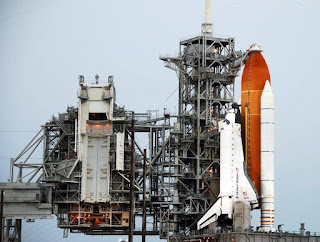 |
We were then taken to the building where spacecraft are de-commissioned. The first shot I took was from under the nose gear bay, with its doors opened wide. Standing under the belly of the spacecraft, looking forward, I couldn’t help but reminisce about the film Close Encounters of the Third Kind and how it might have felt to have a giant spacecraft hovering over your head. It was surreal to look up at this thing called the shuttle and know that it has been to space and back, blasted off from the Launch pad under tremendous combustion power. The exterior’s tiles are actually very small, measuring about six or seven square inches. These tiles protect the spacecraft from both extreme heat and cold. We were able to hold one. Surprisingly, they felt a little like Styrofoam in texture and weight.
Our final tour stop for the day was the launch pad. This really was a once-in-a-lifetime photo opportunity. One surprising sight was the hundreds of NASA cameras, varying in shape and size, mounted alongside the bushes lining the perimeter of the area. They are remote controlled as no living creature in that proximity to a launch would live to tell about it.
The next day was the launch and all systems were set for take off. Fueling the tanks had begun in the wee hours of the morning. We were taken to the operations support building for the pre-launch NASA briefing. The room was filled with politicians, space program officials (U.S.
After the briefing we went outside to the viewing balcony, which is the required three miles from the launch pad. Below us was the giant media “campground” with TV cameras, tents, trucks, platforms, and people. It was almost like observing a carnival. In nervous anticipation, we waited to see if the launch was going to happen. Five minutes before take off an announcement came over the public address system. The shuttle would launch as scheduled. Moments later we heard the official voice counting down and then the rocket engines firing up. We eagerly took one photograph after another as the clouds of exhaust grew, and flames below the engines became evident. They got brighter and bigger, creating a huge cloud stretching out on both sides of the shuttle. Even as far away as our viewing balcony you could feel the intense vibrations as the shuttle lifted off.
And then, what seemed like less then millisecond later, the cloud cover was pierced by the spacecraft, leaving only the long trail of exhaust beneath as proof that it was up there or that it had ever been on the ground.
Adrienne Miller is a recent graduate from Georgia State University Tanzania India and The People of Zanzibar



















No comments:
Post a Comment